450 Years of Jesuits in Brazil
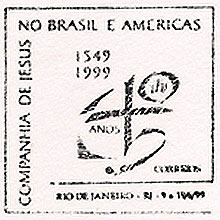

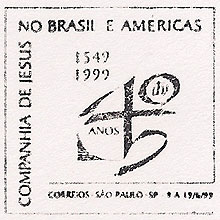
BRAZIL, 1999, to celebrate the 450the anniversary of the arrival of Jesuits
in Brazil this cancel was used in various cities
(above Rio de Janeiro, Salvador, São Paulo)
JESUIT
INSTITUTIONS |
450 Years of Jesuits in Brazil



BRAZIL, 1999, to celebrate the 450the anniversary of the arrival of Jesuits
in Brazil this cancel was used in various cities
(above Rio de Janeiro, Salvador, São Paulo)
The Church of Our Lady of the Assumption, Anchieta
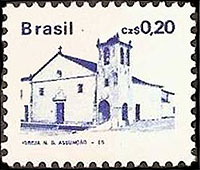
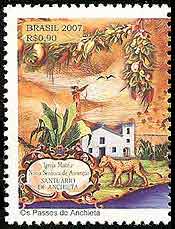
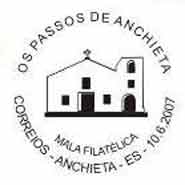
BRAZIL, 1986, the Church of Our Lady of the Assumption in the city of Anchieta, Scott 2057
BRAZIL, 2007, from the Steps of Anchieta issue, Scott 3011 with a special cancel
BRAZIL, 2012, a special cancel for the 415th anniversary of Anchieta city, in Espirito Santo State, showing the old Jesuit churchThe city of Anchieta began as an Indian village called Reritiba (meaning place of the oysters) catechized by the Jesuits in colonial times. The year of its founding as a city in the late 1560s is not certain, but the date, August 15, the feast of the Assumption is agreed upon by all. After the expulsion of the Jesuits from Brazil in 1759, the Portuguese Crown changed Reritiba's status and name to the Village of Benevente and confiscated all the goods of the Jesuits. The church became a parish church, and other parts of the building were used as a city hall and for other purposes. In 1928 the property was returned to the Jesuits who had come back to their apostolic work in the region. The name of the town was officially changed to Anchieta on 30 December 1921. In this place where Saint José de Anchieta died, the Society of Jesus still maintains this parish of Our Lady of the Assumption, the Father Anchieta Spirituality Center (CESPA), and the Father Anchieta Museum (established in 1965). Besides these apostolates the Jesuits have also developed here over the years an educational work in the Movement for the Promotion of Education in the Province of Espírito Santo (MEPES).
The Jesuit Village of Carapicuíba
BRAZIL, 2003, special cancel to celebrate the city's independent existenceJosé de Anchieta established about a dozen villages for the natives, where they could be educated, catechized, and protected from exploitation and slavery. One of these was Carapicuíba, established on 12 October 1580. Over the years it passed from being part of one municipality to another until it finally earned status as a city in March 1965, an event commemorated in the special cancel above. It is part of the National Historical Patrimony as among other things an example of a "Jesuit village." The designed shows the chapel in the center of the village.
Colégio Catarinense, Florianópolis
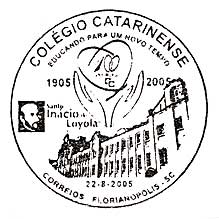
BRAZIL, 2005, the centenary of the Colégio
Catarinense, Florianópolis on the island of Santa Catarina
The Old Jesuit Colleges of Bahia and Rio de Janeiro
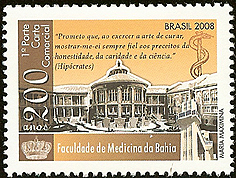
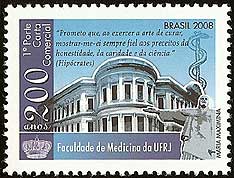
BRAZIL, 2008, the bicentenary of two medical schools, Scott 3037-3038
On January 19, 2012 the brown/orange stamp (Scott 3037) was reissued (Scott
3210)
in sheets of 12 stamps and 12 labels that could be personalized
The issue marking the bicentennial of the Faculties of Medicine in Bahia and Rio de Janeiro (UFRJ) alludes to old Jesuit colleges in each of those cities. Manuel da Nóbrega in 1552 founded the college in Terreiro de Jesus (Jesus Square), the historic center of Salvador (also called Salvador da Bahia or Bahia to distinguish it from other Salvadors). It was run by the Jesuits until their expulsion in 1759, and was attended by the poet Gregório de Mattos and Fr. Antonio Vieira, SJ. The nearby cathedral, built between 1604 and 1656, was originally the college church. At that time it was the largest Jesuit college outside Rome.
The following year, 1553, St. Ignatius created the Province of Brazil and named Nóbrega as first superior of its 30 Jesuits. Under the direction of Nóbrega, another college was founded in 1567 on Morro do Castelo (Castle Hill), the historic heart of Rio de Janeiro. After the expulsion of the Jesuits from Brazil both institutions became conveniently available and had been used to house, in each city, the Royal Military Hospital of that city.
In 1808 the Portuguese Royal Court moved to Brazil to avoid falling into the hands of Napoleon Bonaparte. The Prince Regent Dom João, later King João VI, created in Brazil institutions of higher learning including courses in medicine and surgery in Rio de Janeiro and Salvador da Bahia. In that year the School of Surgery of Bahia was established, the first medical school of Brazil at the old Jesuit College in Bahia; and the School of Anatomy, Surgery and Medicine was founded in the former Jesuit College that had begun on Morro do Castelo in Rio de Janeiro. The courses were at first directed by the University of Coimbra in Portugal. In 1813, both schools were reorganized and transformed into medical-surgical academies. In 1826 they began giving their own degrees independently of Coimbra. In 1832, they became independent medical schools. Eventually both outgrew their original buildings, moved to the new sites pictured on the stamps and became incorporated into Federal Universities as Faculties of Medicine. The old Jesuit college building in Bahia, however, still houses a museum of Brazilian medicine, including books, furniture and equipment connected with the earliest medical courses. Morro do Castelo in Rio was leveled between 1920 to 1924 with all its buildings and used as landfill.
St. Ignatius College, Rio de Janeiro
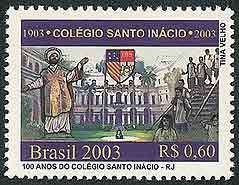
BRAZIL, 2003, the centenary of the school, Scott
2885
The Jesuits were in Rio from its founding. A college of the old Society had begun in 1567 on Morro do Castelo. The present college, Colégio Santo Inácio, opened in 1903, in the rua São Clemente, and during the following 100 years it has been a center of cultural, religious, and educational activity. The lower half of the school's coat of arms is the arms of the Loyola family.
The Church of São Miguel das Missoes, Rio Grande do Sul
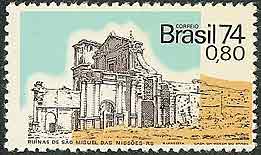
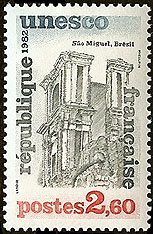
BRAZIL 1974, Scott 1350
FRANCE, 1982, UNESCO World Heritage Sites issue, Scott 2O28
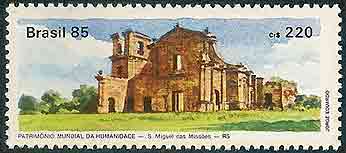
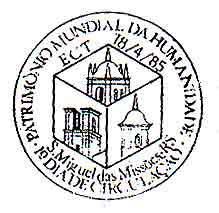
BRAZIL 1985, Scott 1980 and its FDI cancel
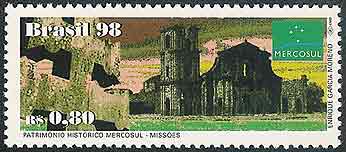

BRAZIL,1998, Scott 2688 and its FDI cancel
São Miguel das Missoes in the Brazilian State of Rio Grande do Sul, was one of the Jesuit missions added to UNESCO's World Heritage List in 1984. It is sometimes referred to as São Miguel Arcanjo since it is dedicated to the archangel Michael, but it should not be confused with the chapel of São Miguel Arcanjo in the state of São Paulo mentioned above. That was first built in 1560. This mission was built between 1735 to around 1745 and was one of many in Argentina, Brazil, Paraguay and Bolivia. Jesuit missionaries founded the mission in part to catechize the Guaraní Indian population and to protect the natives from the Portuguese slave traders. The Treaty of Madrid in 1750 handed sovereignty over the area from Spain to Portugal and the Jesuits were ordered to leave. More
The Jesuit Church and College of São Luiz city, Maranhão State
BRAZIL, 2012, a stamp honoring 400 years of São Luiz city, Maranhão State, showing the Jesuit church and college to the left, Scott 3227The Cathedral of São Luís in Maranhão was originally the old Jesuit church, built beginning in 1690 by the Society of Jesus, and dedicated in 1699 to Our Lady of Light. After the Jesuits were expelled from Brazil in 1759-1760, the church was rededicated to Our Lady of Victory. The plans were drawn up by Father João Felipe Bettendorf, SJ (1625-1698) an early Jesuit missionary from Luxembourg. Beside the church was located in the Jesuit College, a major cultural center of the region; in 1760, its library held 5000 volumes. The Metropolitan Cathedral (also known as the Sé Church) is one of the top attractions in São Luís and one of the city's 7 Treasures of Cultural Material Heritage, chosen by popular vote in 2012 when the city commemorated its 400th anniversary as The American Capital of Culture. Prior to taking up his duties as rector of the College, Fr. Bettendorf, who had once administered the missions in Para, bough the largest canoe he could find, christened it the Saint Ignatius, and paddled his way from Pará to São Luís bringing with him the cocoa seeds that established that crop in the area.
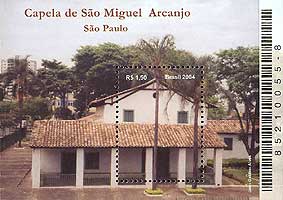
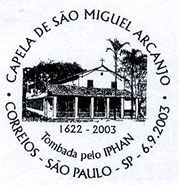
BRAZIL, 2004, the 450th anniversary of São Paulo, Scott 2917 and
a commemorative cancel from 2003
St. José de Anchieta, who came to Brazil in 1553 with other Jesuits, helped establish the village of São Paulo the following year. To keep in contact with converted natives who moved away from the Jesuit College at São Paulo he built small chapels in two native villages, including one in 1560 dedicated to St. Michael the Archangel. It was so named for an angel to whom he had special devotion and who was the patron of his home, São Cristóvão de la Laguna on Tenerife in the Canary Islands. On 18 July 1622, a new chapel replaced the old one thanks to the work of Fr. João Álvares, SJ and a native carpenter Fernão Munhoz. It was remodeled again at the end of the 18th century by the Franciscans, who took over the area when the Jesuits were expelled. As the 450th anniversary of the city was being celebrated, this stamp and souvenir sheet allude to the place played by São Miguel in the history of the city.
The Old College Church, São Paulo
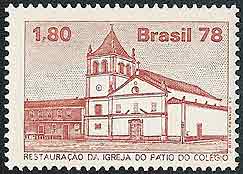
BRAZIL, 1978, to commemorate the restoration of the church, Scott 1572
In 1554 St. José de Anchieta founded a small church, which became the center of Jesuit missionary work in the city and vicinity of São Paulo. By 1681 a college had been added. The Suppression of the Jesuits and later secularization did away with both church and college. The college became a government palace, the church was torn down, and the Patio do Colégio or School Courtyard was renamed the Place du Palais. In 1896 a accurate reproduction of the whitewashed Portuguese Baroque chapel called the Church of the Patio do Colégio, was rebuilt on this spot on the Rua Boa Vista, across the square from the cathedral.

BRAZIL, 2009, images of the Patio do Colégio which appear (upper left corner) on São Paulo sheets (below) the labels of which can be personalized


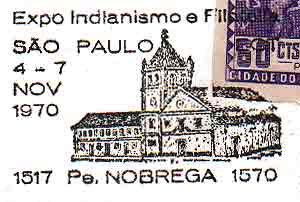
BRAZIL, 1970, show cancel from São Paulo,showing the church where the city was founded
and also honoring Fr. Manuel Da Nóbrega, SJ on the 4th centenary of his death
BRAZIL, 1978, cancel for Scott 1572 above
Saint
Aloysius College, São Paulo
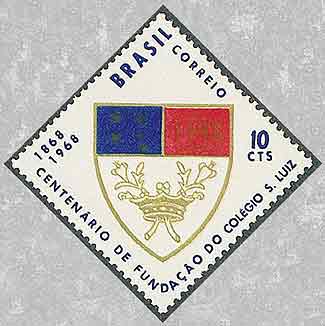
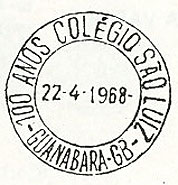
BRAZIL, 1968, the centenary of the school, Scott
1082
and a special centenary cancel.
The State of Guanabara was a former Brazilian state that existed from 1960 to
1975.
It comprised the city of Rio de Janeiro, after the national capital was moved
to Brasília in 1960.
The Italian Jesuits in 1867 began a boarding school in the town of Itú in the State of São Paulo. Civil approval of the school was granted a year later. The estate and building eventually used for the new school, the Colégio São Luiz, was donated by José Galvao Barros Franca, but had once been the estate of José Campos de Lara, a Jesuit who was secularized at the time of the Suppression. The school was transferred to the capital in the 1920s.
Church of Our Lady of the Assumption, Viçosa do Ceará
BRAZIL, 2011, the tercentenary of the ChurchViçosa do Ceará was the first municipality created in the Ibiapaba Mountains, originally inhabited by the Tabajaras Indians. It began as an old Indian village directed by Jesuit priests, but was evacuated between 1590 and 1604 after contact with hostile Frenchmen. Portuguese colonization of the area was attempted again after 1604. The important date of the city, however, was the founding of the Church of Our Lady of the Assumption, built by the Jesuits and natives. The 15th of August 1700 is taken as marking the official founding of the village of Ibiapaba, the future city of Viçosa do Ceará. When the Jesuit missions were abolished in 1759, the village was elevated to a city and its name changed to Vila Viçosa Real da América.
The Church and Colégio de São Tiago, Vitória
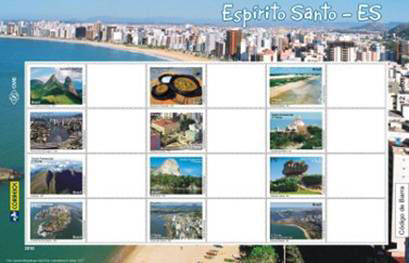
BRAZIL, 2010, the sheet on the left shows twelve scenes of Espírito Santo; the labels to the right of each stamp may be personalized, Scott 3142
The stamp second from the top and the left shows the Anchieta Palace, the former Church and Colégio de São Tiago, Vitória, Scott 3142e
The Anchieta Palace is a 16th-century former Jesuit church and Colégio de São Tiago in Vitória, a city of Espírito Santo State. It's now the seat of state government, although the only part one can enter is the tomb of Saint José de Anchieta. Construction of the college began in 1551 and it was dedicated on 25 July 1551, the feast of St. James, whence its name. Reconstruction of the church and college in stone continued until the first wing of the school was more or less finished when José de Anchieta was provincial in 1587. Anchieta became the rector of the College, and twice a month walked to the town of Rerigtiba, where lived for the ten last years of his life with the Temiminós Indians. In 1707 the second wing is built, facing the Bay of Vitória, and in 1734 the third wing, as well as the second church tower, was completed, closing the internal patio. In 1747 the fourth wing is built, adjacent to the church, making up the impressive quadrangle of what would be, for many years, the largest building in the state. The Jesuits were expelled from the country 1759. In 1798 the old school became the palace of the state government. By 192 after years of fires and reconstruction, the Jesuit influence has disappeared from the facade of the building. In June of 1945 the building was named the Anchieta Palace in honor of Saint José de Anchieta; in 2009 a complete renovation of the building was completed.